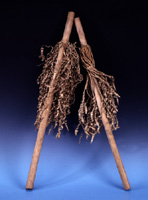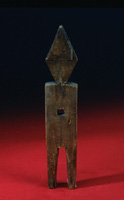The Ainu who live southeast from the mouth of the Amur river belong to classic puzzles of the anthropologists because of their physical appearance and their language that is unrelated to any other known language. They were first mentioned in a Japanese account in 642, and they were reported in Europe in 1586. There had been documents about their trade relations with Japan since the 8th century AD. Since the 13th century, the Ainu joined the Santan trade together with the people along the Amur as important trade partners who mediated between Japan and Manchuria. They gave hide, fur, fish oil, feather and dried fish for metal tools and luxury goods. This trade by barter reached its culmination in the 18th century and began to loose its importance in the 19th century. Parallel to this last development, there is a depopulation among the native people in this area mainly because of the diseases (influenza, smallpox and tuberculosis) which spread through contact with Europeans. They were first mentioned in a Japanese account in 642, and they were reported in Europe in 1586. There had been documents about their trade relations with Japan since the 8th century AD. Since the 13th century, the Ainu joined the Santan trade together with the people along the Amur as important trade partners who mediated between Japan and Manchuria. They gave hide, fur, fish oil, feather and dried fish for metal tools and luxury goods. This trade by barter reached its culmination in the 18th century and began to loose its importance in the 19th century. Parallel to this last development, there is a depopulation among the native people in this area mainly because of the diseases (influenza, smallpox and tuberculosis) which spread through contact with Europeans.
Among the Ainu living on Sakhalin and Hokkaido (and in the past on the Kuril Isles), a large number of ethnographic features is to be seen that are very close to those of the people along the Amur river. They all live in an ecological area which forms a peculiar transition between the arctic and the continental zones. Their way of life shows the nearest parallels with that of the people on the west coast of the Pacific ocean.
The Ainu and the people of the Amur area have been fishers, hunters and foragers. On Sakhalin and at the mouth of the Amur river, seals, walruses, salmons and herrings were mainly killed or captured, along the Amur the fishes of the river played the most important role in the natives' diet. The people along the Amur migrated seasonally between their winter camps where they hunted bears, martens and rabbits and their summer settlements where they returned according to the cyclical migrations of the salmons. On Hokkaido the settlements were more stable and so the deer had a much more important role.
The women collected berries and roots, dried or smoked the food or prepared the furs and hides. They occasionally took part in the net fishing in summer, but the hunting was exclusively a man activity. The winter fur hunting was characteristically market oriented. At the end of the winter, the people turned to fishing under the ice. Although fishing and hunting build even now the traditional occupation of the Ainu and the men along the Amur, the agriculture and the paid work gain more and more ground at present.
In the world view of these native people, almost all natural phenomena were dominated by spirits, there they tried to supplicate them with complex rituals. They feed, for example, the sea with tobacco and sweets at each new fishing season.
The most important part in their religion played the bear, very similarly to other native people in Siberia. They sacrificed each year a bear-cub. The bear ceremony began in spring when the men captured during a hunting a bear-cub. It was fed two years and finally killed ceremonially. The main ceremony, which lasted several days and which was heavily visited also by residents of other villages, was preceded by long preparations.
In the decorative art of the Ainu and the native people of the Amur area, the bark- and wood-carving and bark layering, and the embroidery or layering of hides, fish skins and furs reached a quit remarkable level. A big part of the motives used by them came from China in fairly ancient times. The tattooed mouth among the Ainu women was part of their traditional decorations and pointed to the fact that its wearer was marriageable.
|
Az Amur torkolatától délkeletre lakó ajnuk környezetüktõl egyes részletekben eltérõ antropológiai jellegük, rokontalan nyelvük miatt már régóta a néprajz klasszikus rejtvényei közé tartoznak. A róluk szóló elsõ japán híradást 642-bõl ismerjük, elsõ európai említésük pedig 1586-ból származik. Japánnal való kereskedelmi kapcsolataikról a 8. század óta léteznek írásos források. A 13. századtól az Amur-vidéki népekkel együtt bekapcsolódtak a kiterjedt Szantan kereskedelmi láncba a többi Amur-vidéki néppel együtt, Japán és Mandzsúria között közvetítve. Fémeszközökért, luxuscikkekért prémet, bõrt, halolajat, tollat és szárított halat cseréltek. Ez a cserekereskedelem a 18. században érte el csúcspontját, a 19. században azután jelentõsége visszaesett. A 19. századtól ezzel párhuzamosan nagy mértékû népességcsökkenés figyelhetõ meg ezen a vidéken elsõsorban az európaiak által behurcolt betegségek (influenza, fekete himlõ, tbc) hatására.
 A Szahalin-szigeten és Hokkaidón (valamint korábban a Kuril-szigeteken) élõ ajnuknál sok tekintetben fedezhetõk fel rokon vonások az Amur-vidéki népekkel. Ökológiai környezetük sajátos átmenetet képez az arktikus és a szárazföldi között. Életmódjuk, kultúrájuk a leginkább a Csendes-óceán nyugati partján lakó õslakosokéval mutatja a legtöbb hasonlóságot. A Szahalin-szigeten és Hokkaidón (valamint korábban a Kuril-szigeteken) élõ ajnuknál sok tekintetben fedezhetõk fel rokon vonások az Amur-vidéki népekkel. Ökológiai környezetük sajátos átmenetet képez az arktikus és a szárazföldi között. Életmódjuk, kultúrájuk a leginkább a Csendes-óceán nyugati partján lakó õslakosokéval mutatja a legtöbb hasonlóságot.
Az ajnuk és az Amur-vidéki népek létfenntartása elsõsorban a halászaton, a vadászaton és a gyûjtögetésen alapult. Szahalinon és az Amur torkolatánál a fókának, a rozmárnak, illetve a lazacnak és a heringnek volt nagy szerepe, az Amur mentén pedig a folyami halaknak. Az itteni lakosok a lazacok évszakos ciklusai miatt és a medve, a coboly, valamint a nyest vadászterületeinek minél kedvezõbb elérése érdekében hol nyári, hol téli lakóhelyükre költöztek. Hokkaidón fõképpen a szarvasnak volt fontos a szerepe a települések erõteljesebb szárazföldi jellege miatt.
A nõk elsõsorban gyûjtögetéssel, az élelem tartósításával és feldolgozásával, valamint a bõrök, szõrmék kikészítésével foglalkoztak. A nyári tavi hálós halászatokon a nõk is részt vehettek, a vadászat azonban kizárólag a férfiak foglalatosságának számított. A téli (elsõsorban nyestre és cobolyra történõ) prémvadászat esetében a tevékenység kereskedelmi jelentõsége dominált. Tél végén a jég alatt halásztak az egyes falvak lakói. Bár a halászat és a vadászat szinte napjainkig az ajnu és az Amur-vidéki férfiak hagyományos elfoglaltsága, jelenleg a földmûvelés és a bérmunka egyre nagyobb teret kap.
Az Amur-vidékiek és az ajnuk világképében szinte minden természeti jelenséget szellemek irányítottak, és ezért rítusok bonyolult rendszerével kívánták megnyerni õket. Így például az új halászati idény kezdetekor a tengert dohánnyal és édességgel etették.
Az itt élõ népek vallásának központi részét más szibériai népekhez hasonlóan a medvekultusz, illetve egy medvebocs évenkénti rituális feláldozása képezte. A szertartás tavasszal kezdõdött, amikor vadászat közben elfogtak egy medvebocsot, majd feláldozásáig két évig gondosan nevelték. A több napig tartó fõ ünnepségre, melyre számos településrõl érkeztek rokonok és ismerõsök, tél elõtt, hosszas elõkészületek után került sor.
Az ajnuk és az Amur-vidéki népek díszítõ mûvészetében rendkívül magas szintet ért el a fa, fakéreg faragott, illetve rátétes díszítése, valamint a bõrbõl, halbõrbõl vagy textilbõl készült ruhafélék hímzéses és rátétes díszítése. Az ajnuk lakta terület és az Amur-vidék jellegzetes mintáinak egy része régi kínai díszítésekbõl való kölcsönzés. A tetovált ajak az ajnu nõk hagyományos dísze, ennek elkészültével léptek a lányok a házasulandók sorába.
|







